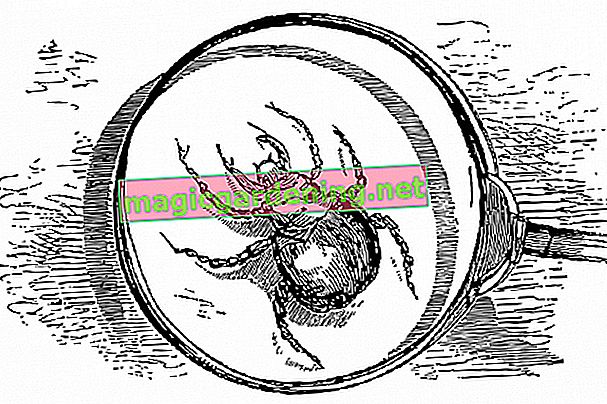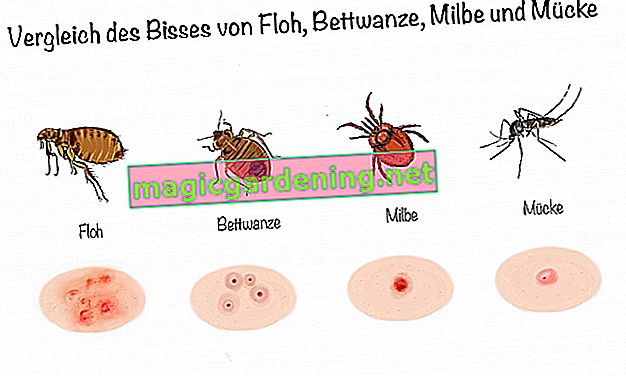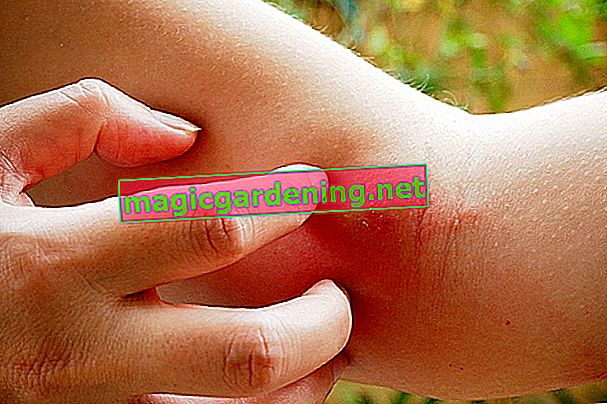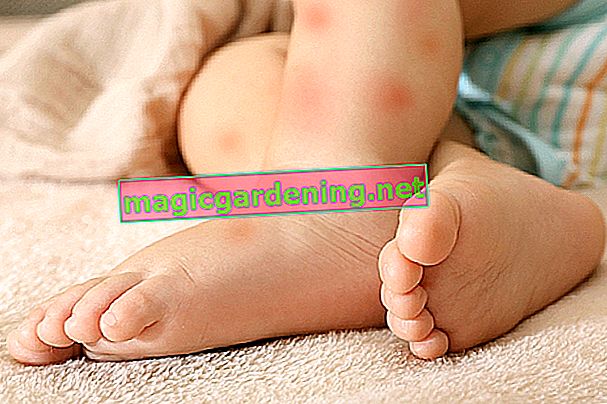
the essentials in brief
- Grass mites don't bite people; Autumn mites do
- Sliced lemons or onions and alcohol disinfect the bite
- Even if the bite is very itchy, avoid scratching as it can lead to inflammation
- The bites can be dangerous for children and allergy sufferers
Grass mite in humans?
Itchy areas near the trunk and intimate areas of the body are sometimes not correctly diagnosed right away. On the one hand, this is due to the fact that the culprit is hiding behind a conspecific. The fact that grass mites are often blamed is due to a widespread misunderstanding of definitions. To put the matter straight: grass mites are usually irrelevant to humans.
also read
- Recognize, treat and prevent fungal infestation on the pasture
- Boxwood: Detect, treat and prevent an infestation with the boxwood moth
- Diseases in the plum tree: identify, treat, prevent
The actual cause of the disease is the autumn mite, which also has a few other common names. These include, for example, autumn grass mite (particularly confusing), harvest mite, hay mite, grass louse, bite, ground louse or peach louse.
The clinical picture that humans show with an autumn mite infestation is called harvest scabies. Why? Because it is a typical phenomenon of the harvest season and was probably an all-too-well-known, unpleasant side effect of the actually happy, richly gifted phase in late summer and autumn in earlier times in peasant circles. Alternatively, the harvest scabies is also called hay scabies, autumn bite or gooseberry disease.
Actually, animals, especially mammals such as mice, other rodents, dogs or cats are parasitized by the "grass mite". Basically, humans only serve the pests as an alternative host - so to speak, when nothing better is available.
Digression
Mites are spiders
By the way: Like all mites, autumn and grass mites are not insects but arachnids. This can easily be seen from the eight legs of the adult animals. But be careful: like insects, the larvae only have six legs! Incidentally, it is the larvae that are important for animals and humans: it is they that attack the skin and cause the itchy bites. Despite their tiny size, they can be seen with the naked eye.Here is a picture so that you can get an idea of the animals:

And here is a brief overview to differentiate between autumn and grass mites:
table:
| Autumn mite | Grass mite | |
|---|---|---|
| Zoological name | Neotrombicula autumnalis | Bryobio Gramineum |
| Alternative common names | Autumn grass mite, harvest mite, hay mite, grass louse, bite, ground louse, peach louse | No |
| Appearance | Larvae up to 0.3 mm, oval, pale orange color; adult animals up to 2 mm in size, wide back shield, double eyes | Significantly smaller than autumn mites, larvae also six-legged, adults eight-legged |
| Relevance to humans | Parasitization in late summer / autumn with frequent contact with grass, severe itching problems | At most, very occasional bites, these itch much less |
How can "grass mite bites" be recognized?
Let's take a closer look at the unsightly evil so that we can grasp it by the head. Typical characteristics of autumn mite bites are as follows:
- several scarlet wheals occurring at the same time, sometimes single, larger, sometimes several small ones like rashes
- preferably on areas close to the torso, in the genital area and in inner bends, preferably those with thin skin and under tight clothing. For example in the groin and lumbar area, under the armpits, in the hollows of the knees and the crooks of the arms or on the wrists and ankles
- often severe itching that can last up to 2 weeks

The characteristic places where the harvest scratches are expressed are the ideal points of attack for the autumn mite larvae, because here they have little corneal layer to pierce and are offered a pleasantly moist and warm environment.
The wheals are not stings, but bites. The arachnids do not have a sting, but rather bite their way through the skin with their mouthparts to get at nutritious cell juices and lymph. The animals do not suck blood. In order to tap into their food, they secrete a salivary secretion when they bite, which dissolves some of the skin tissue. The defensive histamine release that then sets in ensures the itching.
What is the course of the disease?
Attributing the itchy pustules to the autumn mites is not entirely trivial. This is also due to the time it takes for it to break out. The itching does not appear until about 24 hours after the bite, the pustules usually appear a little later.
This is due to the fact that the larva can only create a so-called “pool”, i.e. a channel to the cell sap and the lymph, by working the skin several times with their mouthparts. In addition, warmth of the bed promotes the formation of wheals, which is why one can easily suspect fleas or bed bugs as culprits. It is often not obvious to the layperson that the hay harvest or the picnic in the meadow last weekend could have caused the “bites” that occur later.
The duration of itching and pustular formation
So it takes about 1-2 days for the wheals to develop. But then for some it really gets down to business and severe itching occurs. However, some people also react much less violently to the bites, which is why they sometimes go undetected. The itching, if present, can subside after 3-4 days, but sometimes last up to 2 weeks.
Response varies according to susceptibility
The strength of the reaction of the bitten person depends on the condition of the skin and the general sensitivity. People with soft, thin skin are more susceptible to the parasites anyway. If you are also prone to allergies, you will also release more histamine when infected and develop a more intensive defense reaction.
Scratching makes the discomfort worse

How the bitten behaves is also relevant for the course of the disease. Anyone who is familiar with vermin stings and bites knows that scratching only makes things worse. Because 1. you distribute the injected foreign proteins and enlarge their effective range. And 2. small wounds can form with intense scratching, which in turn can form a conduit for infections such as inflammation and other secondary skin diseases.
General countermeasures
In order to relieve the - as we now know: foreseeable - itching, you can first use normal home remedies and preparations from the pharmacy that also help with insect bites. Examples are:
- Hold sliced lemon on the affected area for anti-inflammatory and irritant relief
- Treat with sliced onion
- Disinfect and cool with 70% cosmetic alcohol, any remaining mites are also killed
- Use anti-allergic, soothing ointments
- If necessary, use hydrocortisone preparations (in higher doses subject to prescription)
Tips
In addition, you should wash all of the items of clothing and bed linen you have worn in the last few days (several times) to remove any mites that may still be living on you!
When are “grass mite bites” particularly dangerous? Indications and remedies

As a rule, an autumn mite infestation is not really critical. Because the larvae of the animals only feed on their host for a few days and then drop off in order to get to the next stage of development with the ingested food. They then become a nymph and then an adult mite, which then only feeds on plants.
Lymphedema
The infestation can become problematic when secondary diseases occur due to intensive scratching and the resulting infections. Bacteria such as streptococci can enter the lymphatic vessels through small scratches and cause edema there. This manifests itself in severe swellings and should be treated by a doctor, especially for people with a weak immune system.
Allergy sufferers
Those who generally tend to allergies also develop a stronger defense reaction to the “grass mite bites” or autumn mite bites. The itching is stronger due to the larger amount of histamine released and blisters can form on the pustules.
Countermeasures:
Antihistamines can be particularly helpful for allergy sufferers. They alleviate the strong defense reaction and the associated itching complaints and thus also prevent superinfections.
Toddlers
The problem with small children is often that they are completely ignorant and trusting with the world and can therefore easily catch mite bites while playing in the grass. In addition, it is more difficult for them to resist the intuitive scratching for the itching. This results in a higher risk of infection, which in turn is more dangerous for the juniors because of their still low body mass and less developed immune defense.
Countermeasures:
Because children can hardly muster the rational discipline to withstand the itching, local itch relievers are initially useful: Home remedies in the form of 70% cosmetic alcohol, lemon juice or onion juice, with which the areas are dabbed, can bring relief. Medical support is certainly advisable in parallel. As with allergy sufferers, antihistamines can reduce itching and the risk of infection by scratching.
"Grass mite bites" on pets
As already mentioned, mammals are much more affected by harvest dross than humans. Mice are the most popular prey for autumn mite larvae, but dogs, cats and horses can also be victims.
The signs of an infestation are basically no different to us: the animal suffers from malaise and scratches, licks and shakes itself incessantly. And scratching can also lead to open, inflammatory areas in four-legged friends. This can be problematic, especially if you bite your head or eye.
dogs

Many dogs love to dig in the ground with paws and snouts and to follow their instincts. In late summer and autumn, they offer the hatching autumn mite larvae ideal opportunities to jump open: the snout, paws and ears are welcome inns for their time up to the nymph stydium.
Cats
Free-range cats that like to roam through tall grass can also be attacked by autumn mites. Basically the same indicators and treatment options apply here.
remedy
If you notice any of the above behavioral signs in your dog, it is a good idea to test him for mites. Comb the fur against the grain in areas at risk (ears, paws) and keep an eye out for the tiny, orange-red animals. They are small, but can be seen with the naked eye. In order to be able to discover them better (this is not easy with reddish fur), you can also spread a white underlay under the combing station and observe whether there are orange-red dots. You should of course also look for pustules on the skin.
So-called repellents are recommended as a preventive measure. They are available in the form of sprays or powders and can be used in the fall mite season between July and October.
Help
First of all, you should shower your four-legged friend thoroughly and also thoroughly clean their blankets, pillows and baskets. If your darling suffers from the itching too much, you can also use special, itch-relieving animal ointments.
As a rule, an autumn mite infestation in pets does not really require treatment, because the mite larvae fall off again after 3-4 days.
frequently asked Questions
What helps with inflammation caused by "grass mite bites"?
Fall mite bites can be excruciatingly excruciating. Hats off to those who can control themselves and don't scratch. However, most of them will not be able to resist the acute relief. If scratching is too intense, minor injuries can quickly lead to inflammation, which can cause even more discomfort.
Redness, pain and, above all, threatened secondary infections can best be alleviated or prevented by disinfection. Cosmetic alcohol (70% from the pharmacy) or the good old household remedies such as the sliced lemon or onion halves are suitable for this. All of this also has a pleasantly cooling and therefore soothing effect. Incidentally, raw potatoes are also a not to be despised option. A compress with diluted vinegar can also help.
Is grass mite infestation contagious?
An autumn mite infestation is not contagious in the classic sense. Because it's not an infection at first.
Nevertheless, an infected person can theoretically “supply” another with the vermin. It is true that the autumn mite larvae usually bite into the skin once and fall off again when they have satisfied their appetite. Under certain circumstances, however, it can also happen that individuals are prematurely stripped of their clothing or bedding. If someone else comes into contact with the textiles, they can become a new victim for the mite larvae.
Is it grass mite or flea bites?
The grouped pustules that are produced by autumn mites can easily be confused with flea bites. In order to get clarity about who is the culprit, you can first do your own investigations:
Basically, there is a higher risk of flea infestation if you are a pet owner. If you suspect that your bites could also come from fleas, inspect your four-legged friend. If you find fleas in him too, you have already achieved extensive clarity.
Nevertheless, you should also consult your dermatologist. A reliable diagnosis can be made here on the basis of a thorough anamnesis and the appropriate therapy initiated.








